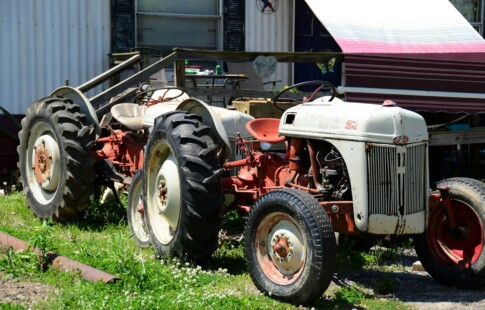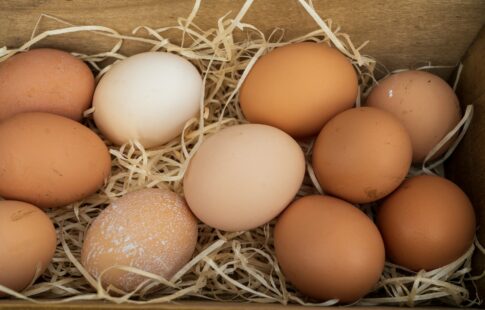
10 Unique Hobby Farm Animals You’ve Probably Never Heard Of
We are reader-supported. When you buy through links on our site, we may earn affiliate commission.
Is this a farm or a circus? From earless goats to dreadlocked donkeys, here are 10 of the most unique hobby farm animals you can raise.
1. Jacob Sheep
This animal looks so bizarre that it was actually used as inspiration for the sheep in the Star Wars spinoff Andor. Bearing up to four massive horns on its head, the Jacob sheep certainly stands out from the flock. Often, one pair of horns curls downward to frame the face while the other two spike straight up.
Farmers typically raise the breed for its meat, wool, and skin. And, for those who aren’t too put off by the idea, some farmers sell Jacob sheep skulls for hundreds of dollars apiece — it’s the breed that truly keeps on giving.
2. Naked Neck Chicken
Though it looks something like a cross between a turkey and a vulture, the naked neck is 100% chicken. This unique hobby farm animal lacks feathers on its neck and sometimes chest, giving it a scrawny appearance only a mother — or a chicken owner — could love.
There is one upside to its sparse feathers, however. This breed can handle heat exceptionally well, making it a good choice for farmers who live in warm climates. Naked neck chickens lay around 100 light brown eggs annually. They’re also a great choice of meat bird because their thin feathers make them easier to pluck.
3. Poitou Donkey
This rare breed of donkey has long, gorgeous locks all over its body. A Poitou’s shaggy hair can actually reach the ground if left uncut, with the hair forming thick cords — much like a Komondor dog — that resemble dreadlocks.
In 1977, there were only 44 Poitou donkeys in the world. Today, there are still just under 500 of them, so consider yourself incredibly lucky if you see one!
4. Lamancha Goat
The Lamancha is the only goat breed developed in the United States. Bizarrely, this goat often lacks external ears, giving its head a streamlined oval shape. Some Lamanchas do have teeny, tiny nubs on the sides of their head, but many do not.
The breed produces very rich milk with a high butterfat content and is prized as a dairy goat. Lamanchas also have sweet temperaments and tend to enjoy human companionship.
5. Göttingen Minipig
The smallest breed of pig in the world is the Göttingen. Make no mistake — it’s still a pretty large animal, weighing around 77 pounds. However, considering that some domestic pigs reach upwards of 1,000 pounds, it’s practically dainty by porcine standards.
Although this breed was developed for biomedical research, these days it’s usually raised as a pet. The minipig’s relatively small size makes feeding and housing it much more affordable.
6. Sebastopol Goose
Like a feather duster come to life, Sebastopol geese with the frizzle gene are adorned with a fluffy mop of shaggy feathers that point in all directions. These birds are usually white with blue eyes or gray with brown eyes, weighing in at 10-14 pounds.
Geese aren’t exactly renowned for their laying abilities — Sebastopol females lay 25-35 eggs per year, with the most prolific goose breeds only producing around 50 eggs annually. Still, they’re beautiful, entertaining birds to have around. Sebastopols were originally bred to use their feathers in quilts and pillows, but today, they also make wonderful pets.
7. Ankole-Watusi Cow
My, what big horns you have! You may have heard of longhorn cattle, but the Ankole-Watusi actually has them beat in terms of the sheer size of their horns. Ranchers typically measure this cattle breed’s massive horns by circumference — up to 30 inches — rather than length, which, by the way, can span up to eight feet.
The ancestors of these cows came from Africa, where they adapted to live for several months under scarce food and water conditions. Their meat has very little fat and cholesterol. Ankole-Watusi cattle are very protective of their young and will bed down in an outward-facing circle with their calves on the inside.
8. Cayuga Duck
Cayuga ducks have the unusual ability to lay black- or gray-shelled eggs, distinct among poultry. The first few eggs of the laying season are usually black. As the season progresses, the ducks lay lighter and lighter eggs until, eventually, they come out white. They lay between 100 and 150 eggs per year.
The ducks themselves are a stunning shade of iridescent black and green, making them a wonderfully unique hobby farm animal. They are generally quiet birds and are easy to tame if raised by hand. Cayuga ducks are also very cold hardy, but they need shade on hot days. They can meet most of their dietary needs by foraging.
9. Dwarf Hotot Rabbit
Could this be the world’s cutest and most unique hobby farm animal? The dwarf Hotot is a round, snow-white bunny with piercing blue eyes. Around each eye is a dark brown or black circle, giving the appearance of perfectly penciled eyeliner.
These bunnies are too small to be of any commercial value. Tipping the scales at just three pounds max, they are, instead, an ornamental breed meant for companionship and show. Their friendly and outgoing nature makes them well-suited to pet life.
10. American Bashkir Curly Horse
As the name suggests, the American Bashkir Curly — also simply known as the Curly — is a horse breed that looks ready for an 80’s prom night. Its entire body, including mane and tail, is covered in tight ringlets of hair. The curly winter coat falls out in summer and returns full force in the fall.
The Curly is a calm, docile horse, but don’t let that fool you. It’s also highly athletic and easily trainable, possessing a hardworking spirit that helps it excel at roping, reining, western pleasure, and competitive trail riding.
Celebrating Uniqueness
Variety is the spice of life. Unique hobby farm animals like curly-haired horses, four-horned sheep and ducks that lay black eggs may not be the most popular livestock around, but they are some of the most spectacular. One thing’s for certain — if you bring home any of these animals, they’ll always be a conversation starter.
Share on
Like what you read? Join other Environment.co readers!
Get the latest updates on our planet by subscribing to the Environment.co newsletter!
About the author
Steve Russell
Steve is the Managing Editor of Environment.co and regularly contributes articles related to wildlife, biodiversity, and recycling. His passions include wildlife photography and bird watching.





